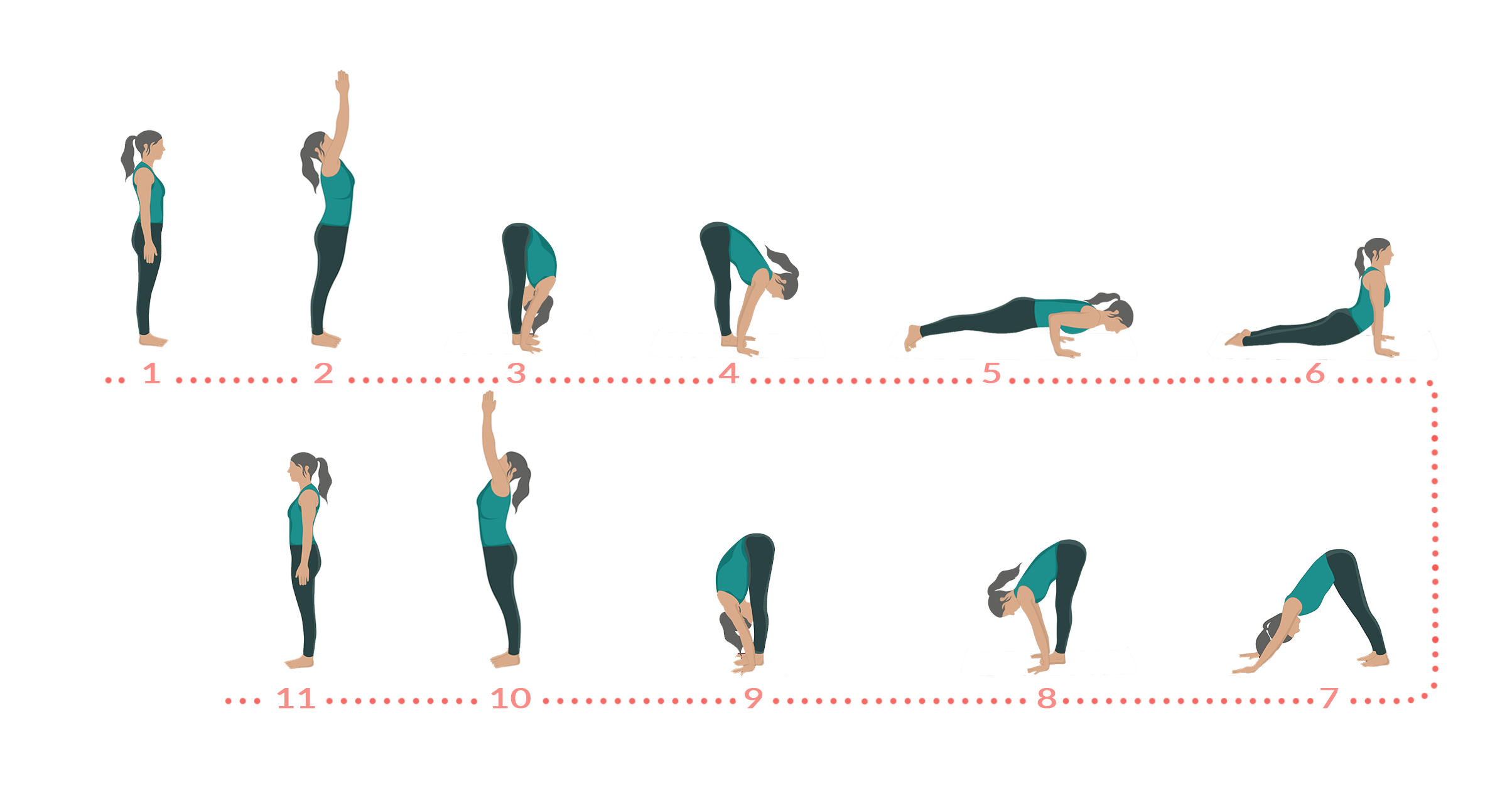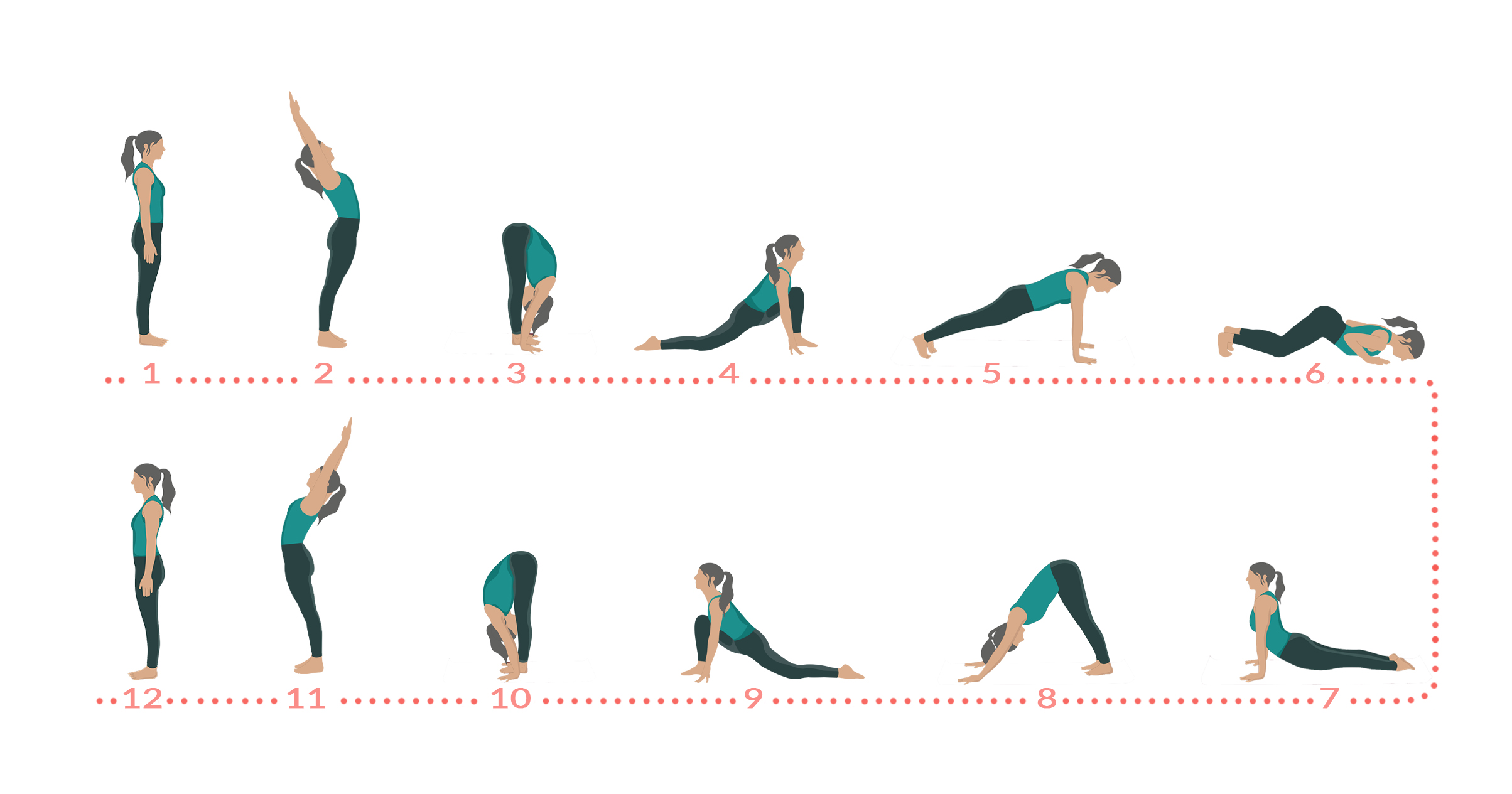'Unlocking the Magic of Surya Namaskar: A Comprehensive Guide to Sun Salutation'
What is Surya Namaskar?
Surya means sun in Sanskrit, while namaskar means hello or welcome. Then say welcome to the sun with Surya Namaskar! An ancient ritual of twelve phases warms the body, preparing it for yoga practise. To that purpose, it is polished for the beginning of a yoga lesson. This warming combination has a long history and several benefits for the body and brain. Continue reading to understand more about this well-known and ancient yoga practise!
Surya Namaskar Kriya
Kriya is a Sanskrit word. It comes from the Sanskrit word kri, which means "to do." Kriya means "activity, deed, or exertion." Consider Sun Welcome as a kriya. Surya Namaskara is a 12 step activity. It is not a series of asanas, contrary to popular belief! Surya Namaskara Kriya is associated with pulling in the sun-oriented plexus to increase sun-based energy within the body as well as with sun-powered energy itself.
The Motivation behind Surya Namaskar
Performing asanas in the beams of the dawn sounds delightful and welcoming however what truly are the justifications for why we ought to rehearse Surya Namaskar?
Surya Namaskar is comprised of 12 stages that are carefully intertwined to help the brain and body in numerous ways.
Surya Namaskar is both a kind of training and a warm-up for subsequent yoga asanas. It considers the "opening" of the body through extending, fortifying, and stretching all muscle groups. Surya Namaskar moves prana, or life force energy, through the body, aiding in the direction of our psychological and physical resources.
The Folklore and Custom Behind Surya Namaskar
According to the Vedas, everything in the cosmos has a male and female side. Gayatri, the feminine aspect of the sun, is described in Hindu tradition as nourishing and nurturing. The masculine aspect of the sun is strengthening, energy-giving, and active, and is represented as Surya in Hindu folklore.
Gayatri represents yin energy, whereas Surya represents yang energy. The goal of Sun Welcome is to warm up and invigorate the body in preparation for the asana practise that follows.
Surya Namaskara Kriya, in contrast to conventional conviction, works on facing away from the rising sun. The goal is to feel the energising and warming sun on your spine while warming up your body with Sun Greetings. In general, one would greet the rising sun with a profound bow and beg heaven, and then go away from the rising light to gather energy on the back of the body.
Surya's tremendous energy gives birth to the planet, and hot energy invigorates the body via the act of Surya Namaskar.
The Advantages of Surya Namaskar
There are different examinations arising on the examinations of Surya Namaskar and yoga as having physical and psychological well-being benefits. As Western and Eastern clinical frameworks blend, the lively advantages of Surya Namaskara likewise arise. Here we take a gander at a portion of these advantages and the association between Surya Namaskar and the chakras.
Actual Medical advantages
- Even though Surya Namaskar can be polished whenever of the day, it is ideal to rehearse at the crack of dawn as sun beams can assist with reviving the body and the psyche. Surya Namaskar should be possible in a 3-speed variety slow, medium, or high speed. An eased back pace assists increment with bodying adaptability, and a medium speed helps in muscle conditioning. Quick-moving rounds of Surya Namaskar are advantageous to one's cardiovascular well-being and can support weight reduction.
- Surya Namaskar further develops blood flow and fortifies heart capability. It additionally upgrades the resting cardiovascular boundaries, for example, systolic circulatory strain, diastolic circulatory strain, and heartbeat pressure.
- Surya Namaskar invigorates a cadenced breathing cycle as breath is synchronized with every development. This discharges the lungs all the more vivaciously and there is a chance for more oxygenated air to top off them.
- More alveoli of the lungs are extended, animated, and afterward purged. Alveoli are a pivotal piece of the respiratory framework related to relaxing. Alveoli are little, expand molded air sacs. They can move oxygen and carbon dioxide (CO2) particles into and out of the circulatory system.
- The oxygen content of the blood is increased by Surya Namaskara's melodic breathing. This improves the oxygenation of the body, especially the heart, and intellect. This melodic breathing and growth also work on the cardiovascular muscles.
- Surya Namaskar is likewise useful for stomach-related well-being and different frameworks of the body as the act of Surya Namaskar cooperates with the organs of the body straightforwardly, by applying pressure, kneading, extending, and generally speaking conditioning up the muscles. This helps the disposal cycles of the body.
Psychological well-being Advantages
The training has psychological well-being benefits. The steady act of Surya Namaskar levels up one's skill to center, works on fearlessness, and assists with creating self-control. It quiets the sensory system and its predictable practice can add to overseeing tension, wretchedness, and sleep deprivation.
How to do Surya Namaskar?
Moving with the Breath
At the point when you in all actuality do Sun Welcome orchestrating the developments of your body with your breath is significant. Every inward breath and exhalation relates to the particular developments of the 12 stages. Because of this synchronous development of body and breath, you figure out how to move your body in a stream and your breath and brain manage.
Going Quick or Slow? What Speed to Decide for Surya Namaskar
Surya Namaskar performed at a sluggish speed
The sluggish Surya Namaskar practice is said to make a reflective difference in the event that the breath and psyche are kept as one. Slow paced Surya Namaskar additionally is useful in fortifying muscles and furthermore works on the working of inward organs. Slow paced Surya Namaskar additionally assists control diastolic blood with forcing. Novices benefit significantly from a sluggish paced practice as their breathing, substantial arrangement and method, and breathing coordination of each step can be focussed on.
Surya Namaskar performed at a middle speed
At the point when Surya Namaskar is finished at a medium speed, its belongings are like those of high impact exercise with expanded solid perseverance and power. A somewhat quicker set of 3 to 12 rounds ought to be finished for the actual advantages. Fledglings ought to begin with 2-4 rounds at a quicker pace and ought to add an additional round after at regular intervals or consistently to keep away from effort.
Surya Namaskar performed at a high speed
Surya Namaskar with faster adjustments is considered a cardiovascular workout.
It helps consume overabundance fat from the body. Quicker adjusts of Surya Namaskar are viewed as excellent as a warm-up work out. More experienced professionals would profit from a quicker pace as they have insight in zeroing in on their breathing, substantial arrangement and procedure, and breathing coordination of each step.
What number of Rounds, How Long? Best Length of Surya Namaskar
- The quantity of rounds to do relies upon different individual variables. It relies upon your ongoing degree of wellness, assuming that any wounds or sicknesses are available and your degree of method. It is ideal to go sluggish, become familiar with the means synchronizing breath to development with five to six rounds. As you develop more fortitude and perseverance, you can move to six rounds. Traditionally in Hatha Yoga, nine rounds of Surya Namaskar are utilized to heat up the body.
- In the event that you have hypertension, hernia, or coronary corridor sicknesses or any wrist, shoulder, lower back wounds, you are educated to rehearse a changed variant regarding Surya Namaskar tracked down additional beneath called the Simple Traditional Surya Namaskara. Those with spine and back issues ought to counsel a specialist prior to rehearsing Surya Namaskar. From that point varieties ought to be looked for from a certified, and fit instructor.
Old style Versus Current Act of Sun Welcome
Surya namaskar poses
Present day Surya Namaskar A (Ashtanga Vinyasa custom)

Old style Surya Namaskara (Hatha Yoga custom)
An Examination
- Remaining forward twist position:In Old style Surya Namaskara the back is adjusted and knees delicate to give a delicate stretch all around the spine. In Ashtanga Vinyasa Surya Namaskara the back is lengthened and knees straight.
- Venturing back to Board:In Old style Surya Namaskara we travel through low jump position with the chest lifted, and pelvis pushing forward. In Ashtanga Vinyasa Surya Namaskara we bounce or immediately step back. In Old Style Surya Namaskara, we move the spine to expand our thoracic and cervical spines softly.In Ashtanga Vinyasa Surya Namaskara we lower level down.
- Descending Confronting Canine: In Traditional Surya Namaskara we keep the feet and hands to the extent that inboard position and plan to bring our chest toward the knees. In Ashtanga Vinyasa Surya Namaskara we abbreviate the position to carry most of the stretch to the rear of our legs and glutes.
- Bringing down to the mat: In Old style Surya Namaskara we move the spine to extend our thoracic and cervical spine tenderly. In Ashtanga Vinyasa Surya Namaskara we lower level down.














0 Comments